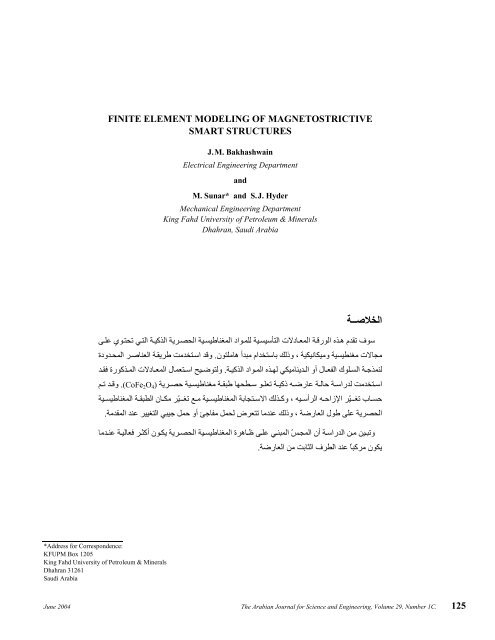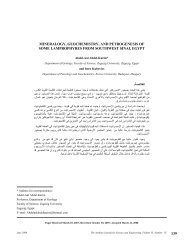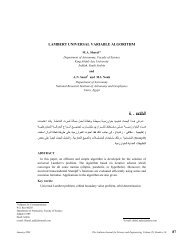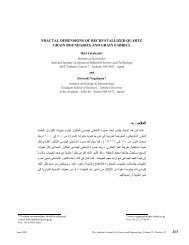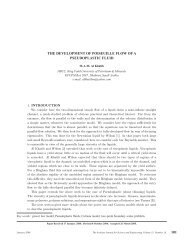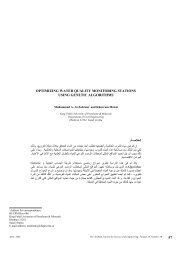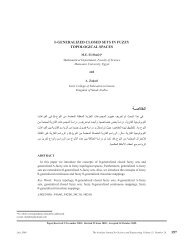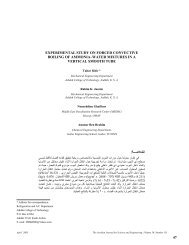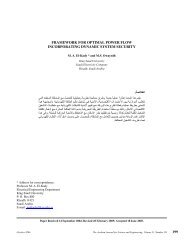finite element modeling of magnetostrictive smart structures
finite element modeling of magnetostrictive smart structures
finite element modeling of magnetostrictive smart structures
You also want an ePaper? Increase the reach of your titles
YUMPU automatically turns print PDFs into web optimized ePapers that Google loves.
FINITE ELEMENT MODELING OF MAGNETOSTRICTIVE<br />
SMART STRUCTURES<br />
J.M. Bakhashwain<br />
Electrical Engineering Department<br />
and<br />
M. Sunar* and S.J. Hyder<br />
Mechanical Engineering Department<br />
King Fahd University <strong>of</strong> Petroleum & Minerals<br />
Dhahran, Saudi Arabia<br />
ﺔــﺻﻼﺨﻟا<br />
ﻰﻠﻋ يﻮﺘﺤﺗ ﻲﺘﻟا ﺔﻴآﺬﻟا ﺔﻳﺮﺼﺤﻟا ﺔﻴﺴﻴﻃﺎﻨﻐﻤﻟا داﻮﻤﻠﻟ ﺔﻴﺴﻴﺳﺄﺘﻟا تﻻدﺎﻌﻤﻟا ﺔﻗرﻮﻟا ﻩﺬه مﺪﻘﺗ فﻮﺳ<br />
ةدوﺪﺤﻤﻟا ﺮﺻﺎﻨﻌﻟا ﺔﻘﻳﺮﻃ ﺖﻣﺪﺨﺘﺳا ﺪﻗو . نﻮﺘﻠﻣﺎه أﺪﺒﻣ ماﺪﺨﺘﺳﺎﺑ ﻚﻟذو<br />
، ﺔﻴﻜﻴﻧﺎﻜﻴﻣو ﺔﻴﺴﻴﻄﻨﻐﻣ تﻻﺎﺠﻣ<br />
ﺪﻘﻓ ةرﻮآﺬﻤﻟا تﻻدﺎﻌﻤﻟا لﺎﻤﻌﺘﺳا ﺢﻴﺿﻮﺘﻟو . ﺔﻴآﺬﻟا داﻮﻤﻟا ﻩﺬﻬﻟ ﻲﻜﻴﻣﺎﻨﻳﺪﻟا وأ لﺎﻌﻔﻟا كﻮﻠﺴﻟا ﺔﺟﺬﻤﻨﻟ<br />
ﻢﺗ ﺪﻗو . (CoFe2O4)<br />
ﺔﻳﺮﺼﺣ ﺔﻴﺴﻴﻃﺎﻨﻐﻣ ﺔﻘﺒﻃ ﺎﻬﺤﻄﺳ ﻮﻠﻌﺗ ﺔﻴآذ<br />
ﻪﺿرﺎﻋ ﺔﻟﺎﺣ ﺔﺳارﺪﻟ ﺖﻣﺪﺨﺘﺳا<br />
ﺔﻴﺴﻴﻃﺎﻨﻐﻤﻟا ﺔﻘﺒﻄﻟا نﺎﻜﻣ ﺮّﻴـﻐﺗ<br />
ﻊﻣ ﺔﻴﺴﻴﻃﺎﻨﻐﻤﻟا ﺔﺑﺎﺠﺘﺳﻻا ﻚﻟﺬآو<br />
. ﺔﻣﺪﻘﻤﻟا ﺪﻨﻋ ﺮﻴﻴﻐﺘﻟا ﻲﺒﻴﺟ ﻞﻤﺣ وأ ﺊﺟﺎﻔﻣ<br />
ﻞﻤﺤﻟ ضﺮﻌﺘﺗ ﺎﻣﺪﻨﻋ ﻚﻟذو<br />
، ﻪﻴﺳأﺮﻟا<br />
ﻪﺣازﻹا<br />
ﺮّﻴـﻐﺗ<br />
بﺎﺴﺣ<br />
، ﺔﺿرﺎﻌﻟا لﻮﻃ ﻰﻠﻋ ﺔﻳﺮﺼﺤﻟا<br />
ﺎﻣﺪﻨﻋ ﺔﻴﻟﺎﻌﻓ ﺮﺜآأ نﻮﻜﻳ ﺔﻳﺮﺼﺤﻟا ﺔﻴﺴﻴﻃﺎﻨﻐﻤﻟا ةﺮهﺎﻇ ﻰﻠﻋ ﻲﻨﺒﻤﻟا ّﺲﺠﻤﻟا نأ ﺔﺳارﺪﻟا ﻦﻣ ﻦﻴﺒﺗو<br />
. ﺔﺿرﺎﻌﻟا ﻦﻣ ﺖﺑﺎﺜﻟا فﺮﻄﻟا ﺪﻨﻋ ًﺎﺒآﺮﻣ نﻮﻜﻳ<br />
*Address for Correspondence:<br />
KFUPM Box 1205<br />
King Fahd University <strong>of</strong> Petroleum & Minerals<br />
Dhahran 31261<br />
Saudi Arabia<br />
June 2004 The Arabian Journal for Science and Engineering, Volume 29, Number 1C. 125
J.M. Bakhashwain, M. Sunar, and S.J. Hyder<br />
ABSTRACT<br />
Constitutive equations <strong>of</strong> <strong>magnetostrictive</strong> <strong>smart</strong> materials containing mechanical<br />
and magnetic fields are presented via Hamilton’s principle. Finite <strong>element</strong> method is<br />
used to model the dynamic behavior <strong>of</strong> these <strong>smart</strong> materials. A <strong>smart</strong> beam structure<br />
consisting <strong>of</strong> a <strong>magnetostrictive</strong> (CoFe2O4) layer on its top surface is considered as a<br />
case study to illustrate the use <strong>of</strong> <strong>magnetostrictive</strong> equations. The location <strong>of</strong> the<br />
<strong>magnetostrictive</strong> layer is varied along the beam and the vertical displacement and<br />
magnetic responses are computed when the system is subjected to step as well as<br />
sinusoidal loads at the tip. It is found from the case study that the <strong>magnetostrictive</strong><br />
sensor is most effective when it is placed at the fixed end <strong>of</strong> the beam.<br />
Keywords: <strong>magnetostrictive</strong> sensor, <strong>finite</strong> <strong>element</strong> method, vibrations, <strong>smart</strong> structure.<br />
126 The Arabian Journal for Science and Engineering, Volume 29, Number 1C. June 2004
J.M. Bakhashwain, M. Sunar, and S.J. Hyder<br />
FINITE ELEMENT MODELING OF MAGNETOSTRICTIVE SMART STRUCTURES<br />
INTRODUCTION<br />
Due to advances in control related technologies there have been an enormous number <strong>of</strong> research activities in so-called<br />
<strong>smart</strong> materials during the last decade. A <strong>smart</strong> material involves interactions between different fields, which allow the<br />
material to be used as a sensor and/or actuator in some manner. Hence the idea <strong>of</strong> a <strong>smart</strong> or an intelligent structure has<br />
been introduced to refer to <strong>structures</strong> that contain <strong>smart</strong> materials and have self-sensing and adaptive capabilities [1, 2].<br />
The phenomenon <strong>of</strong> magnetostriction is defined as an interaction between mechanical and magnetic fields in a body.<br />
This phenomenon was first discovered by Joule in 1842 [3]. Some <strong>of</strong> the <strong>magnetostrictive</strong> materials that can be<br />
mentioned are CoFe2O4, Ni, Alfenol, and Terfenol-D. A numerical simulation scheme for <strong>magnetostrictive</strong> transducers<br />
based on magnetic vector potential formulation was proposed by Kaltenbacher et al. [4]. It was observed that the<br />
coupling <strong>of</strong> magnetic and mechanical systems induced mechanical strains and permeability changes. Experimental and<br />
numerical results were compared and a reasonably good agreement was obtained between the results. The deformation <strong>of</strong><br />
the magnetic material caused by the magnetostriction was represented by an equivalent set <strong>of</strong> mechanical forces by<br />
Delaere et al. [5]. The resulting magnetostriction force was superimposed on the other force distributions, which was the<br />
factor for the coupling <strong>of</strong> mechanical and magnetic systems. A two-dimensional <strong>finite</strong> <strong>element</strong> model was used by<br />
Mohammed [6] to evaluate the force components in magnetostriction phenomenon. The strains developed due to the<br />
presence <strong>of</strong> the magnetic field generated electrical and mechanical forces that created undesirable acoustic noise at low<br />
frequencies. A combined active and passive damping strategy was proposed by Bhattacharya et al. [7] for the control <strong>of</strong><br />
flexible <strong>structures</strong> using <strong>magnetostrictive</strong> and ferro-magnetic alloys. The performance <strong>of</strong> Terfenol-D was affected by<br />
preloading applied to the material. Finite <strong>element</strong> simulations on a cantilever beam model was carried out to study the<br />
dynamic characteristics resulting from the proposed damping approach. An approach was presented by Yamamoto et al.<br />
[8] for monitoring and controlling the preloading in a compact giant <strong>magnetostrictive</strong> positioner. The proposed technique<br />
provided a precise measurement <strong>of</strong> the preloading as well as a sensing capability proportional to the displacement <strong>of</strong> the<br />
positioner.<br />
A thermopiezomagnetic medium was formed by Sunar et al. [9, 10] via bonding together a piezoelectric and<br />
<strong>magnetostrictive</strong> composites. Finite <strong>element</strong> equations for thermopiezomagnetic media were obtained using linear<br />
constitutive equations in Hamilton’s principle together with the <strong>finite</strong> <strong>element</strong> approximations. It was shown that an<br />
electrostatic field applied to the piezoelectric layer causes strain in the structure that in turn produces a magnetic field in<br />
the magnetoceramic layer.<br />
The objective <strong>of</strong> this paper is to develop the dynamic equations <strong>of</strong> a <strong>magnetostrictive</strong> medium via the Hamilton’s<br />
principle and the <strong>finite</strong> <strong>element</strong> method, and to utilize these equations in obtaining the magnetic responses <strong>of</strong> a<br />
<strong>magnetostrictive</strong> layer bonded to the top surface <strong>of</strong> a cantilever beam structure. The structure is acted upon by step and<br />
sinusoidal forces at the tip. The location <strong>of</strong> the <strong>magnetostrictive</strong> sensor is varied along the beam in order to observe its<br />
effect on the magnetic response <strong>of</strong> the sensor. It is well-known that the locations <strong>of</strong> sensors and actuators are very<br />
important to their performance and effectiveness. Research studies were conducted for piezoelectric sensors and<br />
actuators by Sunar and Rao [11], and Sunar [12] for the investigation on the impact <strong>of</strong> placement. The current work<br />
extends these studies to the case <strong>of</strong> <strong>magnetostrictive</strong> sensors.<br />
CONSTITUTIVE EQUATIONS OF MAGNETOSTRICTION<br />
The following equations are written for a <strong>magnetostrictive</strong> medium [10]<br />
T = G ∂<br />
= cS − B<br />
∂S<br />
H = G<br />
∂<br />
∂B = −Τ S + µ −1 B (1)<br />
June 2004 The Arabian Journal for Science and Engineering, Volume 29, Number 1C. 127
J.M. Bakhashwain, M. Sunar, and S.J. Hyder<br />
where c and denote the matrices <strong>of</strong> elastic and <strong>magnetostrictive</strong> stress constants; µ represents the matrix <strong>of</strong> material<br />
permeability; T, S, H, and B are the vectors <strong>of</strong> stress, strain, magnetic field intensity, and magnetic flux density,<br />
respectively. It can be shown that [10] the thermodynamic potential G takes on the following quadratic form:<br />
G = 1<br />
2 S T cS + 1<br />
2 BT µ −1 B − S T B<br />
= 1<br />
2 S T T + 1<br />
2 BT µ −1 B, (2)<br />
using the relation in Equation (1). The Hamilton’s principle is given as<br />
t2<br />
t1<br />
δ∫ ( Ki−Π) dt=<br />
0, (3)<br />
where Ki is the kinetic energy and ∏ is an energy functional, which are defined by<br />
and<br />
1 T<br />
Ki = ∫ ρuu<br />
dt<br />
(4)<br />
V 2<br />
Π =<br />
∫ ∫ ∫ ∫ ∫<br />
GdV u P dV u P dS A JdV A H′ n dS<br />
(5)<br />
T T T T<br />
− b − s − +<br />
V V S V S<br />
where Pb and Ps are the vectors <strong>of</strong> body and surface forces, u, A, J, and n are the vectors <strong>of</strong> mechanical displacement,<br />
magnetic potential, volume current density, and surface normal and H′ E is the matrix <strong>of</strong> external magnetic field intensity,<br />
which is defined in cartesian coordinates as<br />
The variation in G is found as<br />
⎡ 0 Hz −H<br />
⎤ y<br />
⎢ ⎥<br />
HE′ = ⎢−Hz 0 Hx<br />
⎥<br />
⎢ Hy −Hx<br />
0 ⎥<br />
⎣ ⎦<br />
δG = δS T cS + δB T µ −1 B − δS T B− δB T Τ S<br />
= δS T (cS − B) + δB T (− Τ S + µ −1 B)<br />
E<br />
128 The Arabian Journal for Science and Engineering, Volume 29, Number 1C. June 2004<br />
E<br />
. (6)<br />
= δS T T + δB T H, (7)<br />
using Equation (1) and the variation in Ki is written as<br />
t2 t2<br />
T<br />
∫ Ki dt<br />
t ∫ dt dt<br />
1 t ∫ uu . (8)<br />
1 V<br />
δ = − ρδ<br />
Substitution <strong>of</strong> the above equations in Equation (3) yields the following result<br />
t2 t2<br />
⎡<br />
T T T T T<br />
∫ ( ) ∫ ⎢ ∫ ( uu ST BH uPb AJ)<br />
δ Ki−Π dt= dt −ρδ −δ −δ + δ +δ dV<br />
t1 t1 ⎣ V<br />
T T<br />
( s<br />
E′<br />
)<br />
H dS<br />
S<br />
⎤<br />
+ ∫ δu P −δA<br />
n<br />
⎥<br />
= 0. (9)<br />
⎦
Introducing the following relations<br />
J.M. Bakhashwain, M. Sunar, and S.J. Hyder<br />
S = Lu u , B = ∇ × A = LA A (10)<br />
where Lu and LA are differential operators, and substituting Equation (10) into Equation (9) results in the following<br />
equation<br />
t2<br />
t1V (<br />
⎡<br />
T T T T T<br />
dt ⎢ −ρδuu − ( Luδu) T−( ∇ × δ A) H+ δ uP+ δAJ<br />
dV<br />
⎣<br />
∫ ∫ b<br />
T T<br />
( E′<br />
∫ s )<br />
+ δ −δ<br />
S<br />
⎥<br />
⎦<br />
Note the following relations for some terms in Equation (11)<br />
and<br />
H dS ⎤<br />
u P A n = 0. (11)<br />
∫ ∫ ∫<br />
T T T T<br />
V<br />
u<br />
V<br />
u<br />
S<br />
( L δ u) TdV =− δ u ( L T) dV + δu<br />
( NT ) dS<br />
∫ ∫ ∫<br />
T T T<br />
V V V<br />
( ∇×δ A) HdV = ∇ ( δ A× H) dV + δA ( ∇× H ) dV<br />
∫ ∫<br />
T T<br />
= − δ A H′ ndS + δA ( ∇× H ) dV.<br />
(12)<br />
S V<br />
In Equation (12) N is defined in cartesian coordinates as<br />
⎡nx 0 0 ny n 0 ⎤ z<br />
⎢ ⎥<br />
N = ⎢ 0 ny 0 nx 0 nz⎥<br />
⎢ 0 0 nz0 nx n ⎥<br />
⎣ y⎦<br />
where nx, ny, and nz are the components <strong>of</strong> the surface normal n, and H′ is defined as in Equation (6). Equation (11) is<br />
rewritten as<br />
t2<br />
⎡ T T T<br />
∫ ⎢ ∫ δu ( −ρ u + uT<br />
+ Pb) + ∫ δA ( −∇× H + J)<br />
dt L dV dV<br />
⎣<br />
t1V V<br />
T T<br />
( N ) dS ( HEH ) dS<br />
S S<br />
⎤<br />
+ δ − − δ ′ − ′<br />
∫ u Ps T ∫ A n<br />
⎥<br />
= 0. (14)<br />
⎦<br />
Hence, the following equations must be satisfied with appropriate boundary conditions on the corresponding surfaces<br />
−ρ u + L T + Pb=<br />
0<br />
T<br />
u<br />
−∇ × H + J = 0.<br />
(15)<br />
The above equations are the equations <strong>of</strong> motion for the mechanical field and the Maxwell’s equilibrium equation for the<br />
magnetic field, respectively [13].<br />
June 2004 The Arabian Journal for Science and Engineering, Volume 29, Number 1C. 129<br />
)<br />
(13)
J.M. Bakhashwain, M. Sunar, and S.J. Hyder<br />
FINITE ELEMENT FORMULATION<br />
For the <strong>finite</strong> <strong>element</strong> formulation, u and A are chosen variables for the mechanical and magnetic fields, respectively.<br />
The <strong>finite</strong> <strong>element</strong> approximations are written as<br />
ue = Nu ui<br />
Ae = NA Ai<br />
where the subscript e and i respectively stand for the <strong>element</strong> and nodes <strong>of</strong> the <strong>element</strong> and N’s are the appropriate shape<br />
function matrices. Noting the following relations<br />
and<br />
Se = Lu ue = [Lu Nu] ui = Bu ui<br />
Be = LA Ae = [LA NA] Ai = BA Ai<br />
and substituting Equations (1), (16), and (17) in Equation (11) yields the <strong>finite</strong> <strong>element</strong> equations as<br />
Muu u + Kuuu − KuA A = F<br />
−KAuu+ KAA A = M (18)<br />
where u, A, F, and M are the global vectors <strong>of</strong> mechanical displacement, magnetic potential, applied mechanical, and<br />
magnetic excitations, respectively. The <strong>element</strong> matrices and applied excitations in Equation (18) are found as<br />
[Muu]e =<br />
[KuA]e =<br />
Fe =<br />
Me =<br />
∫<br />
Ve<br />
e<br />
T<br />
u u<br />
ρ N N dV , [Kuu]e =<br />
T<br />
∫ Bu eBAdV , [KAA]e =<br />
Ve<br />
∫ ∫<br />
∫<br />
∫<br />
Ve<br />
Ve<br />
T<br />
u e u<br />
T T T<br />
Nu Pbe dV + Nu PsedS + Nu<br />
P ce<br />
Ve Se<br />
∫ ∫<br />
T T<br />
A e − A Ae<br />
Ve Se<br />
B c B dV<br />
T −1<br />
Aµ e A<br />
B B dV<br />
N J dV B H′ n dS<br />
(19)<br />
where KAu= KuA T and the concentrated force Pce is added to the definition <strong>of</strong> Fe.<br />
CASE STUDY<br />
A cantilever steel beam shown in Figure 1 is taken as an example to illustrate the use <strong>of</strong> the derived <strong>magnetostrictive</strong><br />
equations. A <strong>magnetostrictive</strong> (CoFe2O4) layer is bonded to the structure on its top surface and the distance <strong>of</strong> the layer<br />
from the fixed end <strong>of</strong> the beam is denoted by d. The layer is acting as a sensor in response to excitations applied to the<br />
beam. The material properties for the steel and CoFe2O4 are listed in Table 1. The length, width (out <strong>of</strong> plane) and<br />
thickness <strong>of</strong> the beam are taken as 0.12 m, 0.02 m, and 0.001 m, respectively. For the <strong>magnetostrictive</strong> sensor, the<br />
assumed dimensions are 0.004 m for the length, 0.02 m for the width, and 0.002 m for the thickness. Two-dimensional<br />
rectangular <strong>element</strong>s are used for the <strong>finite</strong> <strong>element</strong> formulation <strong>of</strong> the <strong>magnetostrictive</strong> sensor and beam <strong>element</strong>s with<br />
axial degrees <strong>of</strong> freedom for the beam structure. The sensor is divided into two <strong>finite</strong> <strong>element</strong>s and the division <strong>of</strong> the<br />
beam into <strong>finite</strong> <strong>element</strong>s is tuned according to the location <strong>of</strong> the sensor from the fixed end <strong>of</strong> the beam. More<br />
specifically, the number <strong>of</strong> beam <strong>element</strong>s varies from 8 <strong>element</strong>s to 13 <strong>element</strong>s. In all the simulations below, the<br />
system is assumed to have a damping ratio <strong>of</strong> ζ = 0.01, which is typical for a physical system like this.<br />
130 The Arabian Journal for Science and Engineering, Volume 29, Number 1C. June 2004<br />
(16)<br />
(17)
Transient Response<br />
d<br />
Magnetostrictive Layer<br />
Beam<br />
Figure 1. Magnetostrictive system.<br />
Table 1. Properties <strong>of</strong> Materials.<br />
Magnetostrictive Ceramic (CoFe 2O 4)<br />
c 11 (N/m 2 ) 1.54×10 11<br />
31 (N/Wb or A/m) 2.86×10 8<br />
µ 11, µ 33 (H/m) 20π×10 −7<br />
ρ (kg/m 3 ) 7500<br />
Steel<br />
c 11 (N/m 2 ) 2.07×10 11<br />
ρ (kg/m 3 ) 7800<br />
J.M. Bakhashwain, M. Sunar, and S.J. Hyder<br />
The beam is subjected to a unit step force acting upward at its tip. The variable d for the location <strong>of</strong> the sensor is<br />
assumed to be taking on three values: 0 m, 0.03 m, and 0.06 m. The vertical tip deflection <strong>of</strong> the beam as well as the<br />
vertical magnetic potential (Ay) <strong>of</strong> the sensor at its top-right corner are calculated. The time domain and frequency<br />
spectrum plots <strong>of</strong> the system are shown in Figures 2 through 5. It is evident especially from the frequency spectrum plots<br />
that the sensor output tends to fade away as the sensor is placed further away from the fixed end <strong>of</strong> the beam. This is due<br />
to the fact that the first natural frequency is the dominant mode and the beam is strained highest at its fixed end. Hence it<br />
seems reasonable to place the sensor close to or at the fixed end <strong>of</strong> the beam. This is advantageous for applications such<br />
as rotating beams where it would be beneficial to place the sensor at the fixed end <strong>of</strong> the beam to protect it from damage<br />
and at the same time to get the most reading from the sensor. As expected, the fundamental (1 st ) natural frequency <strong>of</strong> the<br />
system at these sensor locations slightly differ, which are computed as 60.87 Hz at d = 0 m, 58.66 Hz at d = 0.03 m, and<br />
57.07 Hz at d = 0.06 m. The variations <strong>of</strong> these natural frequencies are clearly seen in the zoomed magnetic plot <strong>of</strong><br />
Figure 5, which also shows the higher magnetic output at d = 0 m.<br />
Steady-State Response<br />
The steady-state response <strong>of</strong> the system is calculated for a unit sinusoidal force acting upward at the tip <strong>of</strong> the beam.<br />
The forcing frequencies <strong>of</strong> the sinusoidal force are taken as f = 50 Hz, 100 Hz, and 200 Hz and the sensor locations are<br />
assumed at the two limit positions <strong>of</strong> d = 0 m and 0.06 m. The tip deflection and vertical magnetic potential plots are<br />
shown in Figures 6 to 11. It can be seen from these figures that the <strong>magnetostrictive</strong> sensor is able to track the response<br />
<strong>of</strong> the beam at the two extreme locations <strong>of</strong> the sensor. However, higher magnetic peaks at the frequency spectrum are<br />
visible for the sensor output at d = 0 m as compared with the sensor output at d = 0.06 m. Hence, it would again appear<br />
to be reasonable to conclude that it is better to place the sensor at the fixed end than at a location farther away from the<br />
fixed end for the steady-state response monitoring <strong>of</strong> the system. In order to observe the response <strong>of</strong> the <strong>magnetostrictive</strong><br />
sensor to a sinusoidal force acting at the system’s fundamental natural frequency, the forcing frequency <strong>of</strong> the sinusoidal<br />
force is taken as f = 60.87 Hz for d = 0 m. The response is shown in Figure 12, where the forcing frequency is clearly<br />
observed in the frequency spectrum.<br />
June 2004 The Arabian Journal for Science and Engineering, Volume 29, Number 1C. 131
J.M. Bakhashwain, M. Sunar, and S.J. Hyder<br />
Tip Deflection (m)<br />
PSD <strong>of</strong> Tip Deflection<br />
Tip Deflection (m)<br />
PSD <strong>of</strong> Tip Deflection<br />
3<br />
2<br />
1<br />
x 10-3<br />
0<br />
0 0.02 0.04 0.06 0.08 0.1<br />
Time (s)<br />
5<br />
4<br />
3<br />
2<br />
1<br />
x 10-5<br />
0<br />
0 100 200 300 400 500<br />
Frequency (Hz)<br />
-8<br />
0 0.02 0.04 0.06 0.08 0.1<br />
Time (s)<br />
132 The Arabian Journal for Science and Engineering, Volume 29, Number 1C. June 2004<br />
Vertical MP (Wb/m)<br />
PSD <strong>of</strong> Vertical MP<br />
2<br />
0<br />
-2<br />
-4<br />
-6<br />
2<br />
1.5<br />
1<br />
0.5<br />
x 10-5<br />
x 10-8<br />
0<br />
0 100 200 300 400 500<br />
Frequency (Hz)<br />
Figure 2. Vertical tip deflection and magnetic potential (MP) at d = 0 m for unit step input.<br />
4<br />
3<br />
2<br />
1<br />
x 10-3<br />
0<br />
0 0.02 0.04 0.06 0.08 0.1<br />
Time (s)<br />
6<br />
4<br />
2<br />
x 10-5<br />
0<br />
0 100 200 300 400 500<br />
Frequency (Hz)<br />
Vertical MP (Wb/m)<br />
PSD <strong>of</strong> Vertical MP<br />
2<br />
0<br />
-2<br />
-4<br />
x 10-5<br />
-6<br />
0 0.02 0.04 0.06 0.08 0.1<br />
Time (s)<br />
1<br />
0.8<br />
0.6<br />
0.4<br />
0.2<br />
x 10-8<br />
0<br />
0 100 200 300 400 500<br />
Frequency (Hz)<br />
Figure 3. Vertical tip deflection and magnetic potential (MP) at d = 0.03 m for unit step input.
PSD <strong>of</strong> Vertical MP<br />
Tip Deflection (m)<br />
PSD <strong>of</strong> Tip Deflection<br />
4<br />
3<br />
2<br />
1<br />
x 10-3<br />
0<br />
0 0.02 0.04 0.06 0.08 0.1<br />
Time (s)<br />
6<br />
4<br />
2<br />
x 10-5<br />
0<br />
0 100 200 300 400 500<br />
Frequency (Hz)<br />
Vertical MP (Wb/m)<br />
PSD <strong>of</strong> Vertical MP<br />
J.M. Bakhashwain, M. Sunar, and S.J. Hyder<br />
-3<br />
0 0.02 0.04 0.06 0.08 0.1<br />
Time (s)<br />
June 2004 The Arabian Journal for Science and Engineering, Volume 29, Number 1C. 133<br />
0<br />
-1<br />
-2<br />
5<br />
4<br />
3<br />
2<br />
1<br />
x 10-5<br />
x 10-9<br />
0<br />
0 100 200 300 400 500<br />
Frequency (Hz)<br />
Figure 4. Vertical tip deflection and magnetic potential (MP) at d = 0.06 m for unit step input.<br />
4.5<br />
4<br />
3.5<br />
3<br />
2.5<br />
2<br />
1.5<br />
1<br />
0.5<br />
x 10-9<br />
d = 0 m<br />
d = 0.03 m<br />
d = 0.06 m<br />
0<br />
0 20 40 60<br />
Frequency (Hz)<br />
80 100 120<br />
Figure 5. Sensor output spectrum at various sensor locations.
J.M. Bakhashwain, M. Sunar, and S.J. Hyder<br />
Tip Deflection (m)<br />
PSD <strong>of</strong> Tip Deflection<br />
5<br />
0<br />
x 10-3<br />
-5<br />
0 0.02 0.04 0.06 0.08 0.1<br />
Time (s)<br />
8<br />
6<br />
4<br />
2<br />
x 10-3<br />
0<br />
0 100 200 300 400 500<br />
Frequency (Hz)<br />
-1<br />
0 0.02 0.04 0.06 0.08 0.1<br />
Time (s)<br />
134 The Arabian Journal for Science and Engineering, Volume 29, Number 1C. June 2004<br />
Vertical MP (Wb/m)<br />
PSD <strong>of</strong> Vertical MP<br />
1<br />
0.5<br />
0<br />
-0.5<br />
3<br />
2<br />
1<br />
x 10-4<br />
x 10-6<br />
0<br />
0 100 200 300 400 500<br />
Frequency (Hz)<br />
Figure 6. Vertical tip deflection and magnetic potential (MP) at d = 0 m for unit sinusoidal input with f = 50 Hz.<br />
Tip Deflection (m)<br />
PSD <strong>of</strong> Tip Deflection<br />
0.01<br />
0.005<br />
0<br />
-0.005<br />
-0.01<br />
0 0.02 0.04 0.06 0.08 0.1<br />
Time (s)<br />
0.015<br />
0.01<br />
0.005<br />
0<br />
0 100 200 300 400 500<br />
Frequency (Hz)<br />
Vertical MP (Wb/m)<br />
PSD <strong>of</strong> Vertical MP<br />
5<br />
0<br />
x 10-5<br />
-5<br />
0 0.02 0.04 0.06 0.08 0.1<br />
Time (s)<br />
8<br />
6<br />
4<br />
2<br />
x 10-7<br />
0<br />
0 100 200 300 400 500<br />
Frequency (Hz)<br />
Figure 7. Vertical tip deflection and magnetic potential (MP) at d = 0.06 m for unit sinusoidal input with f = 50 Hz.
Tip Deflection (m)<br />
PSD <strong>of</strong> Tip Deflection<br />
1<br />
0.5<br />
0<br />
-0.5<br />
x 10-3<br />
-1<br />
0 0.02 0.04 0.06 0.08 0.1<br />
Time (s)<br />
4<br />
2<br />
x 10-4<br />
0<br />
0 100 200 300 400 500<br />
Frequency (Hz)<br />
Vertical MP (Wb/m)<br />
PSD <strong>of</strong> Vertical MP<br />
J.M. Bakhashwain, M. Sunar, and S.J. Hyder<br />
-4<br />
0 0.02 0.04 0.06 0.08 0.1<br />
Time (s)<br />
June 2004 The Arabian Journal for Science and Engineering, Volume 29, Number 1C. 135<br />
4<br />
2<br />
0<br />
-2<br />
3<br />
2<br />
1<br />
x 10-5<br />
x 10-7<br />
0<br />
0 100 200 300 400 500<br />
Frequency (Hz)<br />
Figure 8. Vertical tip deflection and magnetic potential (MP) at d = 0 m for unit sinusoidal input with f = 100 Hz.<br />
Tip Deflection (m)<br />
PSD <strong>of</strong> Tip Deflection<br />
1<br />
0.5<br />
0<br />
-0.5<br />
x 10-3<br />
-1<br />
0 0.02 0.04 0.06 0.08 0.1<br />
Time (s)<br />
3<br />
2<br />
1<br />
x 10-4<br />
0<br />
0 100 200 300 400 500<br />
Frequency (Hz)<br />
Vertical MP (Wb/m)<br />
PSD <strong>of</strong> Vertical MP<br />
1<br />
0.5<br />
0<br />
-0.5<br />
x 10-6<br />
-1<br />
0 0.02 0.04 0.06 0.08 0.1<br />
Time (s)<br />
3<br />
2<br />
1<br />
x 10-10<br />
0<br />
0 100 200 300 400 500<br />
Frequency (Hz)<br />
Figure 9. Vertical tip deflection and magnetic potential (MP) at d = 0.06 m for unit sinusoidal input with f = 100 Hz.
J.M. Bakhashwain, M. Sunar, and S.J. Hyder<br />
Tip Deflection (m)<br />
PSD <strong>of</strong> Tip Deflection<br />
1<br />
0.5<br />
0<br />
-0.5<br />
x 10-4<br />
-1<br />
0 0.02 0.04 0.06 0.08 0.1<br />
Time (s)<br />
2.5<br />
2<br />
1.5<br />
1<br />
0.5<br />
x 10-6<br />
0<br />
0 100 200 300 400 500<br />
Frequency (Hz)<br />
-1<br />
0 0.02 0.04 0.06 0.08 0.1<br />
Time (s)<br />
136 The Arabian Journal for Science and Engineering, Volume 29, Number 1C. June 2004<br />
Vertical MP (Wb/m)<br />
PSD <strong>of</strong> Vertical MP<br />
1<br />
0.5<br />
0<br />
-0.5<br />
2.5<br />
2<br />
1.5<br />
1<br />
0.5<br />
x 10-5<br />
x 10-8<br />
0<br />
0 100 200 300 400 500<br />
Frequency (Hz)<br />
Figure 10. Vertical tip deflection and magnetic potential (MP) at d = 0 m for unit sinusoidal input with f = 200 Hz.<br />
Tip Deflection (m)<br />
PSD <strong>of</strong> Tip Deflection<br />
1<br />
0.5<br />
0<br />
-0.5<br />
x 10-4<br />
-1<br />
0 0.02 0.04 0.06 0.08 0.1<br />
Time (s)<br />
1.5<br />
1<br />
0.5<br />
x 10-6<br />
0<br />
0 100 200 300 400 500<br />
Frequency (Hz)<br />
Vertical MP (Wb/m)<br />
PSD <strong>of</strong> Vertical MP<br />
5<br />
0<br />
x 10-6<br />
-5<br />
0 0.02 0.04 0.06 0.08 0.1<br />
Time (s)<br />
8<br />
6<br />
4<br />
2<br />
x 10-9<br />
0<br />
0 100 200 300 400 500<br />
Frequency (Hz)<br />
Figure 11. Vertical tip deflection and magnetic potential (MP) at d = 0.06 m for unit sinusoidal input with f = 200 Hz.
Vertical MP (Wb/m)<br />
PSD <strong>of</strong> Vertical MP<br />
CONCLUSIONS<br />
2<br />
1<br />
0<br />
-1<br />
x 10-3<br />
J.M. Bakhashwain, M. Sunar, and S.J. Hyder<br />
-2<br />
0 0.01 0.02 0.03 0.04 0.05<br />
Time (s)<br />
0.06 0.07 0.08 0.09 0.1<br />
1.5<br />
1<br />
0.5<br />
x 10-3<br />
0<br />
0 10 20 30 40 50 60 70 80 90 100<br />
Frequency (Hz)<br />
Figure 12. Vertical magnetic potential (MP) at d = 0 m for unit sinusoidal input with f = 60.87 Hz.<br />
The linear constitutive equations <strong>of</strong> magnetostriction are presented. The differential equations governing dynamic<br />
behavior <strong>of</strong> a <strong>magnetostrictive</strong> material are also given. The <strong>finite</strong> <strong>element</strong> method is applied to the material to obtain the<br />
coupled <strong>finite</strong> <strong>element</strong> equations, which are used in <strong>modeling</strong> and analyzing the illustrative system consisting <strong>of</strong> a<br />
cantilever beam and a <strong>magnetostrictive</strong> sensor. The location <strong>of</strong> the sensor is varied on the beam to observe its effect on<br />
the sensor’s response.<br />
The magnetic potential outputs <strong>of</strong> the sensor indicate that it can be utilized to monitor the dynamic response <strong>of</strong> the<br />
system. It is noticed from the simulation results on this cantilever beam structure that the <strong>magnetostrictive</strong> sensor<br />
produces magnetic outputs <strong>of</strong> higher magnitude when it is close to or at the fixed end <strong>of</strong> the beam. The location <strong>of</strong> the<br />
sensor has also an effect on the fundamental natural frequency <strong>of</strong> the system. This effect can be minimized by keeping<br />
the size <strong>of</strong> the sensor to be as small as possible. Hence, the conclusion is that it is advantageous to place the<br />
<strong>magnetostrictive</strong> sensor at the fixed end <strong>of</strong> cantilever beam <strong>structures</strong>. Similar conclusions were reached in the literature<br />
for piezoelectric sensors and actuators [11, 12]. It is hoped that this preliminary study will pave way for other research<br />
works that will include both <strong>magnetostrictive</strong> sensors and actuators for dynamic system sensing and control.<br />
ACKNOWLEDGMENT<br />
The authors gratefully acknowledge the support provided by King Fahd University <strong>of</strong> Petroleum & Minerals through<br />
Fast-Track Project # FT/2001-11.<br />
June 2004 The Arabian Journal for Science and Engineering, Volume 29, Number 1C. 137
J.M. Bakhashwain, M. Sunar, and S.J. Hyder<br />
REFERENCES<br />
[1] E.F. Crawley, “Intelligent Structures for Aerospace: A Technology Overview and Assessment,” Journal <strong>of</strong> Aircraft,<br />
32(8) (1994), pp. 1689–1699.<br />
[2] M. Sunar and S.S. Rao, “Recent Advances in Sensing and Control <strong>of</strong> Flexible Structures via Piezoelectric Materials<br />
Technology”, ASME Applied Mechanics Reviews, 52 (1999), pp. 1–16.<br />
[3] C. Body, G. Reyne, and G. Meunier, “Modeling <strong>of</strong> Magnetostrictive Thin Films, Application to a Micromembrane”, Journal <strong>of</strong><br />
Physics III France, 7 (1997), pp. 67–85.<br />
[4] M. Kaltenbacher, S. Schneider, and H. Landes, “Nonlinear Finite Element Analysis <strong>of</strong> Magnetostrictive Transducers”, Smart<br />
Structures and Materials 2001 – Modeling, Signal Processing and Control in Smart Structures, 4326 (2001), pp. 160–168.<br />
[5] K. Delaere, W. Heylen, R. Belmans, and K. Hameyer, “Strong Magnetomechanical Coupling Using Local Magnetostriction<br />
Forces”, EPJ Applied Physics, 13 (2001), pp. 115–119.<br />
[6] O.A. Mohammed, “Coupled Magnetoelastic Finite Element Formulation <strong>of</strong> Anisotropic Magnetostatic Problems”, IEEE<br />
Southeast Conference, 2001, pp. 183–187.<br />
[7] B. Bhattacharya, B.R. Vidyashankar, S. Patsias, and G.R. Tomlinson, “Active and Passive Vibration Control <strong>of</strong> Flexible<br />
Structures Using a Combination <strong>of</strong> Magnetostrictive and Ferro-magnetic Alloys”, SPIE – International Society for Optical<br />
Engineering, 2000, pp. 204–214.<br />
[8] Y. Yamamoto, H. Eda, and J. Shimizu, “Application <strong>of</strong> Giant Magnetostrictive Materials to Positioning Actuators”,<br />
IEEE/ASME International Conference on Advanced Intelligent Mechatronics, 1999, pp. 215–220.<br />
[9] M. Sunar, “Modeling <strong>of</strong> Coupled Mechanical, Electrical, Thermal and Magnetic Fields”, International Thermal Energy<br />
Congress, July 8–12, 2001, Cesme, Izmir, Turkey.<br />
[10] M. Sunar, A.Z. Al-Garni, M.H. Ali, and R. Kahraman, “Finite Element Modeling <strong>of</strong> Thermopiezomagnetic Smart Structures”,<br />
AIAA Journal, 40(9) (2002), pp. 1846–1851.<br />
[11] M. Sunar and S.S. Rao, “Distributed Modeling and Actuator Location for Piezoelectric Control Systems”, AIAA Journal,<br />
34(10) (1996), pp. 2209–2211.<br />
[12] M. Sunar, “Thermopiezoelectric Sensor Design and Placement”, Recent Advances in Transport Phenomena, The 12 th<br />
International Symposium on Transport Phenomena. ed. I. Dincer and M.F. Yardim. Paris, France: Elsevier, 2000, pp. 665–669.<br />
[13] M.N.O. Sadiku, Elements <strong>of</strong> Electromagnetics, 2 nd edn. New York: Oxford University Press, 1995, ch. 9.<br />
Paper Received 16 November 2003; Revised 23 May 2004; Accepted 13 October 2004.<br />
138 The Arabian Journal for Science and Engineering, Volume 29, Number 1C. June 2004


